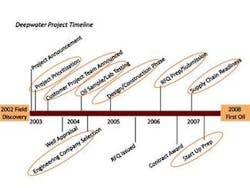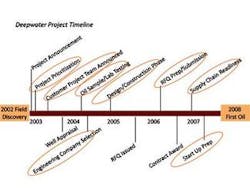Optimizing production strategies for remote, deepwater locations
Stephen Horner, Champion Technologies
With global reserves of technically recoverable heavy oil estimated at more than 400 Bbbl, it is easy to see a time in the near future when heavy oil could become a mainstay of world energy supplies.
Even though producers attempting to recover heavy oil must overcome a number of special production problems, interest in and investigation of the resource are growing. Already, heavy-oil projects producing for years in Venezuela and Canada are expected to propel both countries into the ranks of the world’s leading oil-producing nations within the next few years. Offshore, exploration and development companies have discovered substantial reserves of heavy oil in deepwater reservoirs offshore Brazil and in the Gulf of Mexico, several of which appear to be solid candidates for commercial development.
Unfortunately, the principle characteristic properties that make heavy oil so difficult to produce onshore are specific gravity of 22° API or less, viscosity of at least 100 centipoises (cP), and high contents of asphaltenes, heavy metals, sulfur, and nitrogen. These orders of magnitude make it more difficult to produce offshore, especially from reservoirs in several thousand feet of water. If the location of a deepwater, heavy-oil discovery precludes transportation from the well site via subsea pipeline, storage and offloading issues add an entirely new level of complexity to the equation.
Address complexities early
The earlier in the prospect-evaluation process that complexities of producing heavy oil in deepwater at remote locations are identified and addressed, the greater the benefits. This is especially true in ascertaining how heavy and/or highly viscous fluids can be expected to react physically and chemically when subjected to deepwater production forces.
Many mechanical and/or chemical solutions useful for producing heavy oil onshore or in shallow water either must be adapted to fit the pressure and temperature conditions encountered in deepwater or disregarded altogether. For example, thermal production schemes in most cases cannot be replicated offshore due to lack of fuel for efficiently generating heat. Logistical barriers, such as insufficient storage space or resupply requirements, similarly rule out injecting a diluent to decrease the specific gravity of a heavy-oil production stream and make it easier to pump.
Because artificial lift must be used to move heavy oil from a deepwater wellhead on the seafloor upward through thousands of feet of water to a floating production facility, it is imperative that an operator determine how the production stream will behave under gas lift or when subjected to the shear forces generated by an electrical submersible pump. There are no guarantees that production equipment and production system configurations capable of successfully producing light oil in deepwater will be effective for recovering heavy oil in similar deepwater settings.
Understanding reactivity
Production chemicals and application programs designed to resolve emulsions, manage asphaltenes, minimize naphthenate deposition, clarify produced water, control corrosion or wax, or dehydrate heavy oil onshore or in shallow water, must be re-qualified for the more challenging production conditions in deepwater. Even contaminants, such as water, salt, clay, and/or sand, can influence the way in which a specific heavy-oil accumulation behaves when perturbed by drilling and/or production operations, and also must be taken into account when evaluating a heavy-oil discovery.
More fully understanding the physical and chemical reactivity of the constituents of a heavy-oil production stream can enable an operator to select a production chemical program to minimize production costs and to optimize project performance. Better understanding also can help a producer minimize upfront capital investment, while avoiding equipment or production system components that could impair operating economics by restricting flow or creating other production problems.
For example, if the physical attributes of a heavy-oil prospect indicate that an operator can produce from the reservoir and/or inject chemicals subsea, he might be able to improve the flow characteristics by completing wells subsea. Or, if the composition of reservoir fluids indicates that gas lift might destabilize of asphaltenes in the production stream, finding the chemistry that keeps the asphaltenes from depositing can make gas lift a viable option. For that reason, it is highly recommended that a deepwater operator consult with a production chemical advisor with experience formulating chemical solutions and application methods for producing heavy oil, qualifying chemicals for deepwater projects, and stabilizing oil for storage aboard an FPSO vessel, as soon as possible after initial well test samples are gathered.
In fact, an operator will benefit from the guidance of experienced, external chemical advisors before initiating front-end engineering and design (FEED) of any deepwater production system intended to recover heavy oil at a remote location.
Valued experience
All production companies have competent chemists on staff playing key roles in every step of the exploration, development, and production process. Experienced in-house chemical advisors help evaluate oil and gas discoveries by providing important insights into the decision of whether to develop a prospect.
In many instances, however, the expertise of an in-house chemical advisor is influenced by experience working on the production company’s projects. That’s significant, because E&P companies tend to specialize at what they do best; some work onshore, while others focus offshore; some develop expertise in recovering gas from tight reservoirs, while others try to capitalize on special insights into producing coalbed methane.
As the industry expands into deepwater heavy oil production, production company chemists and engineers are starting to learn how heavy or highly viscous fluids behave in a reservoir under several thousand feet of water. Integrated specialty chemical companies can field teams of chemists who not only have the collective experience to tackle such issues, but also know the latest production-chemical technology and have experience applying state-of-the-art chemical capabilities at the well site.
Project planning, execution
In one recent application offshore China, an independent production company was resigned to selling its first load of heavy oil produced via FPSO in Bohai Bay at a reduced price because it was far off market specifications. However, the deepwater team of the operator’s external chemical advisor anticipated the problem and installed a custom-designed chemical-injection skid aboard the FPSO to formulate the optimal chemical demulsifier to be adjusted on-the-fly.
By adjusting the demulsifier as the operator brought on first oil, the operator obtained full value for the first shipment of oil to avoid millions of dollars in lost revenue. Since that initial demonstration, external chemical advisors have continued to help the operator adjust demulsification and naphthenate-inhibitor chemical formulas to fit changing circumstances as new wells are brought on-line and as reservoir characteristics evolve.
Incremental gains in project planning and execution can benefit complex, high-cost projects.

